

King David is well represented in the Index of Medieval Art database, with close to 200 subject headings covering the various scenes of his life. He is most often depicted as a richly garmented king, often with his role as the psalmist suggested by his signature harp and crown. One variant of his iconography, which I encountered while cataloguing a historiated initial from an early sixteenth-century French Psalter, presents a familiar subject in the life of David, described by the Index as David, Communicating with God (Fig. 1). However, in this example, the kneeling David adds an extra gesture to his prayer routine. Where one would expect to find reverent folded hands, David emphatically points his finger to his protruding tongue!
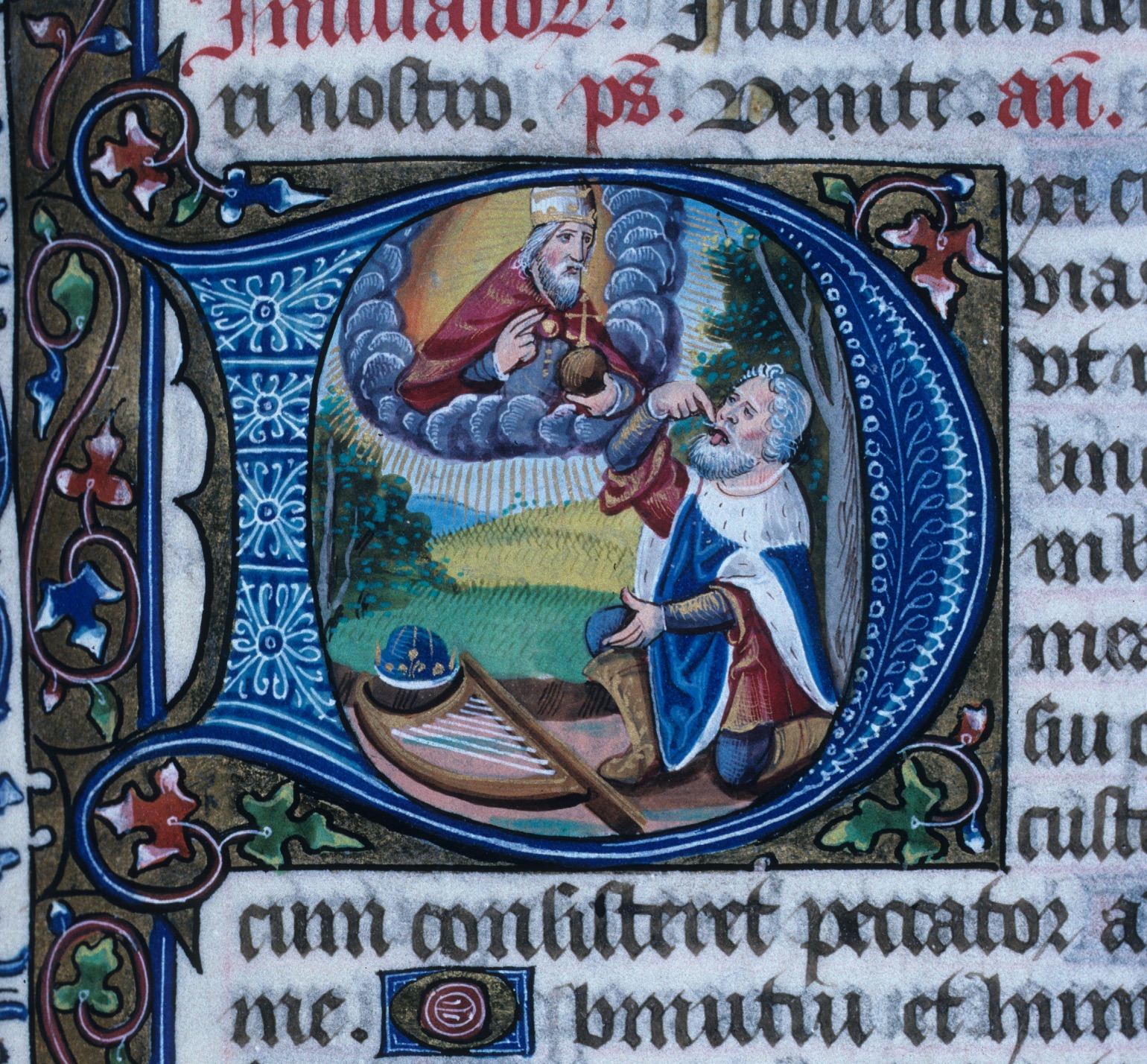
While studying this initial, I decided to use the tools in the updated Index database to explore how David’s pose and the purposeful indication of his tongue were related to the psalm verse. In this Psalter, the initial D for Dixi begins Vulgate Psalm 38, verse 2: Dixi custodiam vias meas; locutus sum in lingua mea posuri ori meo custodiam cum consisteret peccator adversum me… (Douay-Rheims Bible, accessed 22 February 2019, http://drbo.org/). Translated, this reads “I will take heed to my ways, that I sin not with my tongue. I have set guard to my mouth, when the sinner stood against me.” The tongue is mentioned one more time in this psalm at verse 5 with regard to speech, “I spoke with my tongue: O Lord, make me know my end. And what is the number of my days: that I may know what is wanting of me” (drbo.org). The image of David thus prefigures the textual passages of the psalm in that both image and text suggest the speaking and offending capabilities of the tongue. But, how often do we see David depicted with his tongue sticking out? And can we find other contexts for his expressive gesture?
I entered a simple keyword search for “tongue” in the upper right search bar on the Index database homepage and used the Subject Filter to refine my results to David, Communicating with God. Immediately, I located a much earlier scene from a Parisian Bible in the Morgan Library dated to the first quarter of the thirteenth century (Fig. 2). This initial D, also beginning Psalm 38, encloses a beardless, crowned David, looking up toward the face of God and mirroring the action of raised finger to outstretched tongue.
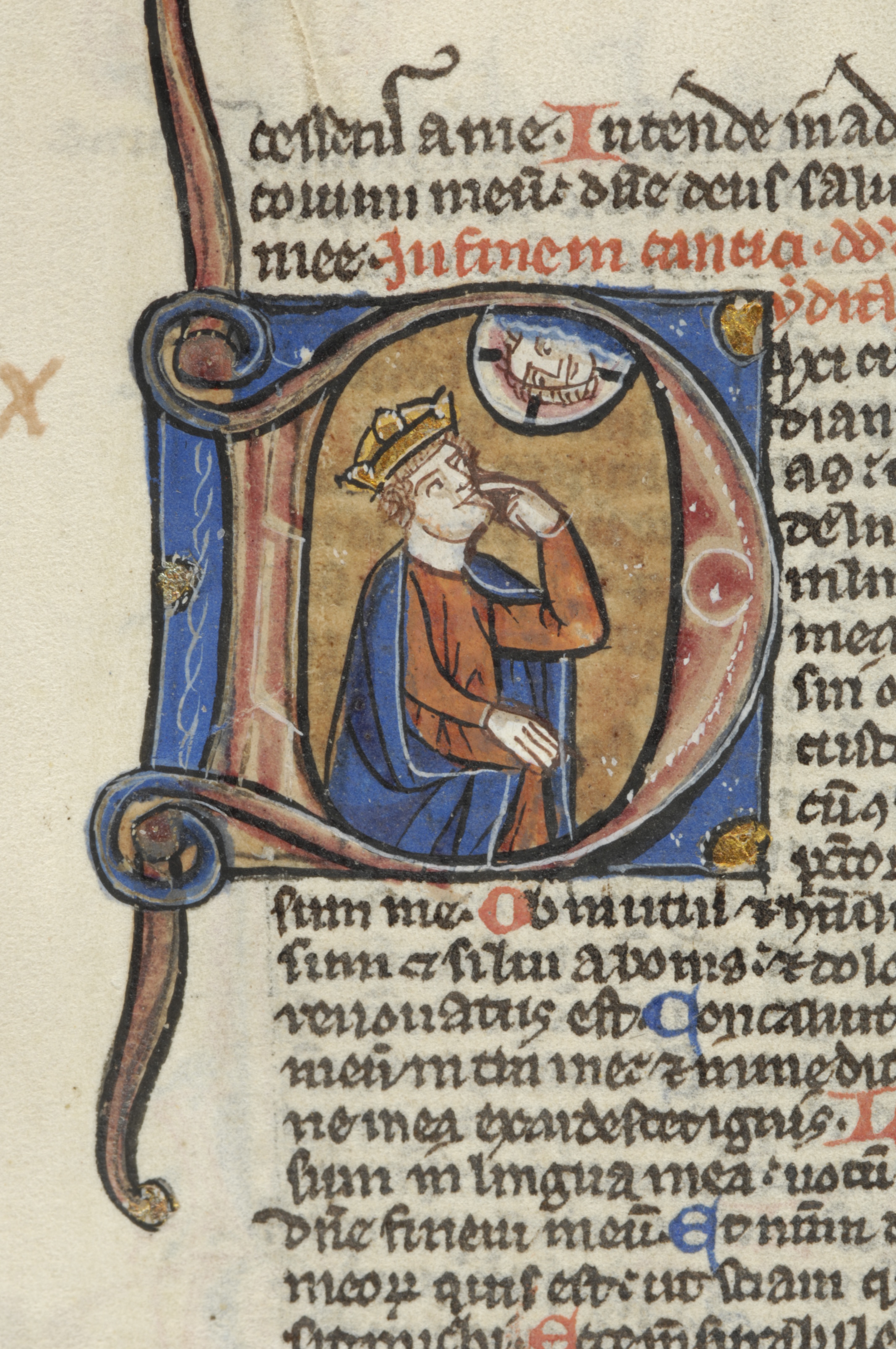
Since both of these images open Psalm 38, the presence of magnified tongues seems intended to show that significant body part that David was obliged to “sin not” with.
This connotation of the image is better understood in the context of the medieval preoccupation with the peccata linguae, or “sins of the tongue,” such as those assigned to fallen characters in the Divine Comedy and the Roman de la Rose. These transgressions of speech include flattery, duplicity, evil counsel, discord, and blasphemy. Medieval moralists also were concerned with sinful tongues: the Franciscan John of Wales (d. 1285), for example, wrote a preaching treatise called De Lingua (“The Tongue”), which outlined the proper duties of a “good” tongue as to share in ethical knowledge and to oppose its own natural “bad” inclinations.
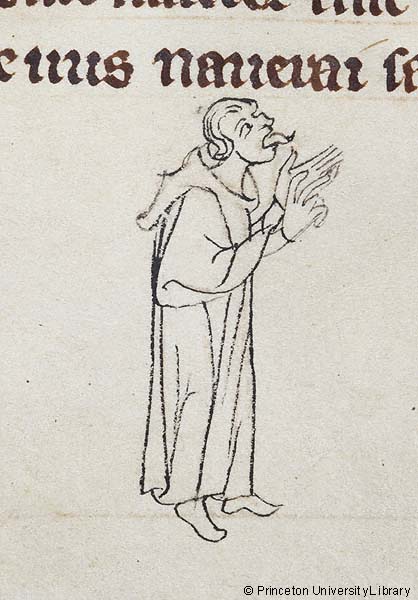
In medieval art, depictions of sinful tongues like David’s can be found in figural representations of Slander, False Seeming, and other personifications of vice. A figure identified as the Unmerciful Judge sticks out his tongue in the lower margin of a 15th century Manuel des Péchés to illustrate the Exemplum, or lesson, for the Sins of Avarice and Covetousness (Fig. 3). His long, curled tongue and raised hands suggest how insistently he imparts this lesson on the vices. However, his prominent tongue is also inherently tied to his cruel speech, offering a visual metaphor of merciless judgment.
Wishing to investigate further the iconography associated with Psalm 38, I used the Index database to browse through the numbered psalms in the Subject Browse List. Clicking the subject heading for Psalm 039 (Vulg., 038) revealed that a majority of the illustrations depict David pointing to his mouth, a common way to represent speech, but without his tongue sticking out. One such initial appears in the Noyon Psalter, attributed to the Master of the Ingeborg Psalter, in the J. Paul Getty Museum (MS. 66, fol. 41v). This suggests that the literal representations of David’s tongue were the more unusual depiction. To take this theory a step further, I repeated the keyword search for “mouth” and refined the subject to David, Communicating with God. This search yielded about 30 examples where David was indicating his closed mouth, a subject that is particularly common in manuscript initials associated with Psalm 38.
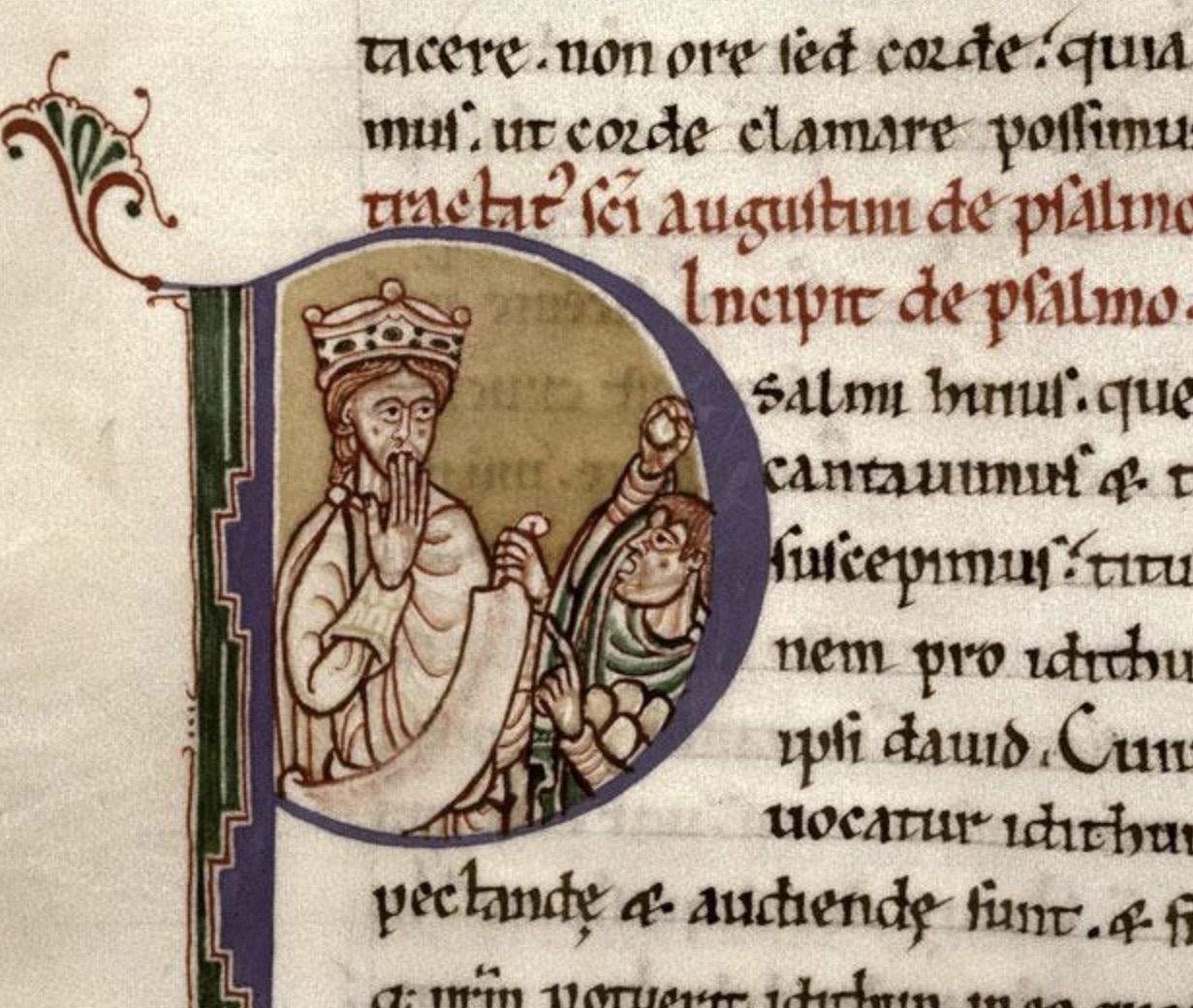
Medieval commentaries on Psalm 38 help to explain the popularity of this iconography. Theodoret’s Commentary on Psalm 38 notes the text’s emphasis on the sinfulness and “lowliness” of human nature and humanity’s need for deliverance, while Augustine wrote of the same psalm that, although the tongue was “prone to slip,” bridling it will help one stand against wicked enemies. Both commentators connected Psalm 38 to an episode in Samuel, where David was viciously pursued by Absalom and abused by Shimei, who threw sticks and stones at him while he fled from Jerusalem. That biblical narrative itself is sometimes found illustrating Psalm 38 (see the related Index subject heading David, Cursed by Shimei). In a manuscript of the Enarrationes in Psalmos, dating to the mid twelfth century, a historiated initial P encloses a crowned David covering his mouth while Shimei hurls stones at him (Fig. 4). Here, David’s cautious gesture and muted tongue show his restraint from sin, shedding light on the meaning of the gesture when it appears in the psalm initials.
Finally, I decided to broaden my search to locate all depictions of this particular body part with David. I repeated the keyword search for “tongue” and set the Subject Filter to David. This led me to a historiated initial in the twelfth century English manuscript of the Saint Albans Psalter and to another layer of iconographic context. Here, the initial E for Erucatavit, beginning Vulgate Psalm 44, encloses a seated and crowned David, who raises a pen in his right hand and with his left index finger points to his extended tongue (Fig. 5). Written in red ink above the incipit is the rubric Lingua me calamus scribae, taken from verse 2 of that Psalm, which can be translated as, “My tongue is the pen of a scrivener”(drbo.org). This verse of Psalm 44 is preceded by the mention of David’s verbum bonum, or the “good word” uttered from his heart to the king (mea regi), suggesting that goodness issues from him and through him, by way of tongue and pen.
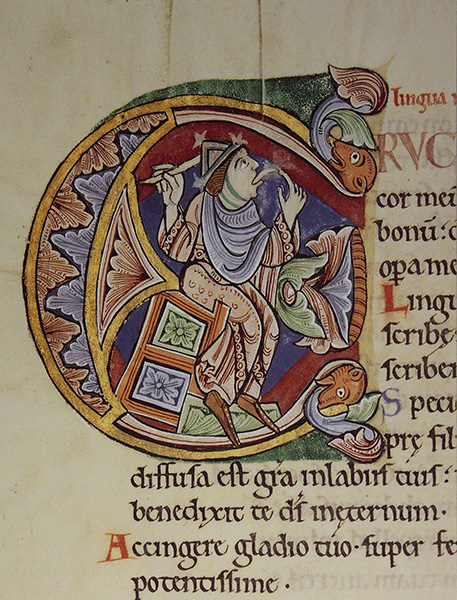
With regard to this Vulgate Psalm 44, Augustine comments,
What likeness, my brethren, what likeness, I ask, has the “tongue” of God with a transcriber’s pen? What resemblance has “the rock” to Christ? (1 Corinthians 10:4) What likeness does the “lamb” bear to our Saviour (John 1:29), or what “the lion” to the strength of the Only-Begotten? (Revelation 5:5)
(Augustine, Expositions, Digital Psalms version, p. 264)
Today, we enjoy ample use of emojis, which add expressive meaning to our messages to one another. In the Middle Ages, manuscript illuminators did not miss the opportunity to illustrate textual passages with similarly expressive visual cues in images, which also linked to the complex layers of meaning readers anticipated finding in the psalms. Although David’s gesture to his closed mouth seems to be a relatively common composition, the emphasis on his stuck-out tongue in certain depictions speaks just as expressively of its sinful capabilities as it does of its usefulness as an obedient tool.
The investigation of David’s “emoji” highlights how researchers can look for specific iconographic motifs in the Index by combining keyword searches in the description field and filtering with controlled headings in Advanced Search options. For advice on your own research topic and forming search strategies using the Index database, send us a Research Inquiry. We’ll be 🙂 to hear from you!
Sources
Baika, Gabriella I. “Lingua Indiciplinata: A Study of Transgressive Speech in the ‘Romance of the Rose’ and the ‘Divine Comedy.’” PhD diss., University of Pittsburgh, 2007.
Craun, Edwin D. Lies, Slander, and Obscenity in Medieval English Literature: Pastoral Rhetoric and the Deviant Speaker. Cambridge: Cambridge University Press, 2005. See especially pp. 33–34.
Douay-Rheims Bible. Accessed 22 February 2019. http://drbo.org/.
Gellrich, Jesse M. “The Art of the Tongue: Illuminating Speech and Writing in Later Medieval Manuscripts.” In Virtue & Vice: The Personifications in the Index of Christian Art, 93–119. Princeton: Princeton University Press, 2000. See especially pp. 108–109.
Hill, Robert C. “Commentary on Psalm 39.” In Commentary on the Psalms, Psalms 1–72, 233–36. Washington, D.C.: Catholic University of America Press, 2000. St. Aurelius Augustine. Expositions on the Psalms, Digital Psalms version 2007, 205–216, 262–277. Accessed 22 February 2019. https://faculty.gordon.edu/hu/bi/ted_hildebrandt/otesources/19-psalms/text/books/augustine-psalms/augustine-psalms.pdf. See especially pp. 205–206, 264–265.
Going to Kalamazoo this year? Ever wanted to learn more about the impact of digital tools and methods on medieval art research? Be sure to circle your programs for two exciting sessions on current topics in iconography, a roundtable and a workshop, co-organized by Maria Alessia Rossi and Jessica Savage of the Index of Medieval Art.
I. Saturday, May 11 at 10:30am [Session 346]
Encountering Medieval Iconography in the Twenty-First Century: Scholarship, Social Media, and Digital Methods (A Roundtable)
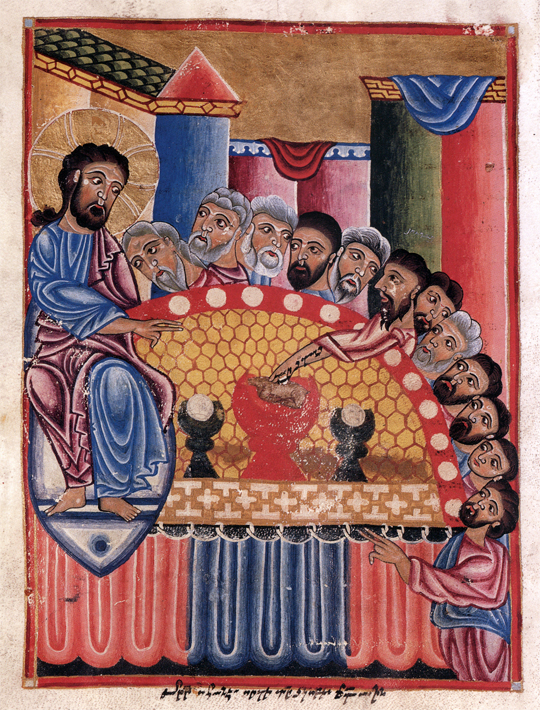
Stemming from the launch of the new database and enhancements of search technology and social media at the Index of Medieval Art, this roundtable addresses the many ways we encounter and access medieval iconography in the 21st century. Our five participants will speak on topics relevant to their area of specialization and participate in a discussion on how they use online resources, such as image databases, to incorporate the study of medieval iconography into their teaching, research, and public outreach.
Digital Information and Interoperability: Facing New Challenges with Mandragore, the Iconographic Database of the BnF
Sabine Maffre, Bibliothèque nationale de France
Ontology and Iconography: Defining a New Thesaurus of the OMCI at the Institut National d’Histoire de l’Art, Paris
Isabelle Marchesin, Institut National d’Histoire de l’Art (INHA)
Iconography at the Missouri Crossroads: Teaching the Art of the Middle Ages in Middle America
Anne Rudloff Stanton, Univ. of Missouri
Medieval Iconography in the Digital Space: Standardization and Delimitation
Konstantina Karterouli, Dumbarton Oaks
Online Resources in the Changing Paradigm of Medieval Studies
Marina Vicelja, Center for Iconographic Studies, Univ. of Rijeka
II. Sunday, May 12 at 8:30am [Session 505]
Lost in Iconography? Exploring the New Database of the Index of Medieval Art (A Workshop)
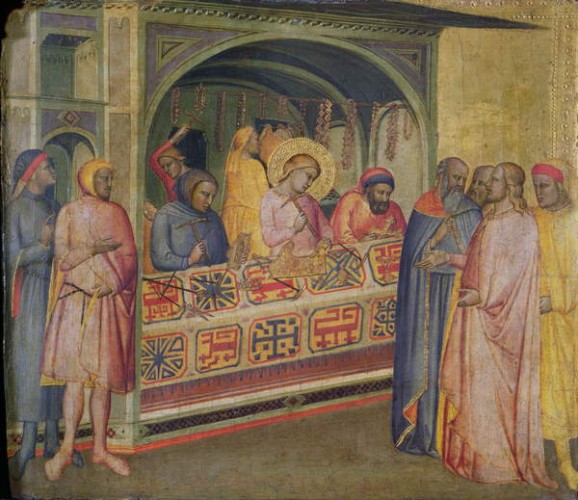
This workshop will demonstrate how to get the most out of the new Index of Medieval Art database by using advanced search options, filters, and browse tools to research iconographic subjects. A short presentation will introduce the new subject taxonomy search tool that will further facilitate exploration of the online collection.
We look forward to an invigorating discussion on current issues in iconographic research and to sharing an update on the new database. You can find out more about the 54th International Congress on Medieval Studies at Kalamazoo, held from 9-12 May 2019, including the full schedule here.
The Index is happy to host the scholarly conference “Abstraction before the Age of Abstract Art,” organized by Profs. Elina Gertsman (Case Western Reserve University) and Vincent Debiais (École des hautes études en sciences sociales) with the generous support of the Samuel H. Kress Foundation, the French-American Cultural Exchange Foundation, Case Western Reserve University, and the École des hautes études en sciences sociales. The conference will be held on May 18, 2019; speakers include Jean-Claude Bonne,
Licia Buttà, Vincent Debiais, Thomas Golsenne, Herbert Kessler,
Robert Mills, and Cécile Voyer.
A full schedule and free registration form will be available after April 7 at https://ima.princeton.edu/conferences.
